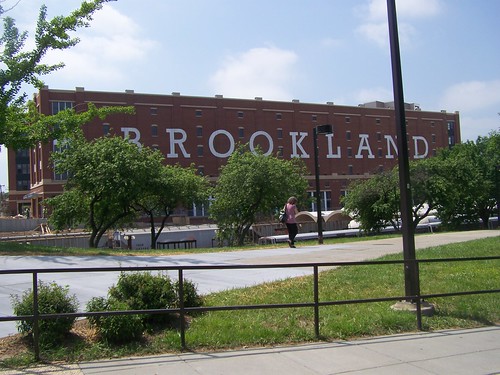Catholic University bookstore to move to Monroe Street Market project
 When I was involved in the Brookland Main Street program, and in other writings, I suggested that to better connect Catholic University to the neighborhood, that the college bookstore should be moved out from the campus to the community.
When I was involved in the Brookland Main Street program, and in other writings, I suggested that to better connect Catholic University to the neighborhood, that the college bookstore should be moved out from the campus to the community.I can't remember everything I said, but I am sure I outlined this among other ideas (including moving CUA's arts related academic departments to the area of the campus closest to Monroe Street and moving the Hartke Theater there from its location on Harewood Road) during the first Advisory Committee meeting for the Brookland Small Area Plan back in 2007.
Yesterday's Post announced that CUA college bookstore, run by Barnes and Noble, will be moved to an off-site campus adjacent location, into the Monroe Street Market project which is constructed on land owned by Catholic University ("Barnes & Noble to open store for Catholic University in Northeast DC"). When finished, the development will have about 900 apartments, retail, and artist work and studio spaces.
(My criticism of the failure to have a Brookland specific cultural plan in place to better leverage the development's plan for arts uses is discussed here: "Where's the there? To get visitation to neighborhoods there must be destinations worth visiting.")
Barnes and Noble College Division, technically a company separate from the retail bookstore chain, has been moving their college bookstores to in-city locations adjacent to the college campuses they serve for some time.
 JHU Flickr photo of their college bookstore on St. Paul Avenue in Charles Village, Baltimore.
JHU Flickr photo of their college bookstore on St. Paul Avenue in Charles Village, Baltimore.I no longer remember where they did this first, but the store for the College of William and Mary has been off-campus for many years. Later, they moved the Johns Hopkins bookstore to Charles Village (as part of a JHU building) and the same goes for the bookstore for the University of Baltimore, which is now located in an apartment building located next to the campus and the light rail station, about two blocks from Penn Station.
These bookstores aren't full-blown bookstores oriented to non-college students, but by leveraging the steady business of college textbook sales, they allow neighborhoods to have bookstores when they otherwise couldn't pull it off. And for those of us who like to look at lists of books for college classes, to introduce ourselves to more specialized items, it's great.
Anyway, I discussed the idea of better leveraging local universities for community improvement more generally in the blog entry, "University-related urban revitalization."
And just the other day I came across a book that looks pretty interesting, published by the University of Minnesota Press, The City as Campus: Urbanism and Higher Education in Chicago, which explores urban campuses, their design, and town-gown interaction. I'd expect its conclusions to be applicable to other cities.
Other books I need to read on this topic are:
• The University as Urban Developer, from the Lincoln Land Institute, which has sponsored a technical assistance programs for colleges doing these kinds of projects.
• The University and Urban Revival, by Judith Rodin, former president of the University of Pennsylvania, which mounted a large-scale program for revitalization the the neighborhoods around the campus, after previously considering moving to a suburban location.
• Building Ideas: An Architectural Guide to the University of Chicago, about the UC campus specifically and its evolution since the university's founding in 1890. (The book focuses specifically on the campus, and doesn't cover interaction and connection between the campus and the Hyde Park community that surrounds it.)
Anyway, the development at CUA is very interesting because before agreeing to the Monroe Street Market project (also see "Shops begin to open at Brookland Metro development" from Greater Greater Washington), the university was more interested in turning the student gaze inward.
Part of the reason they built a great new student union in the early part of the last decade--which includes the bookstore in its current incarnation and a Starbucks coffee shop--was to provide more reasons for students to stay on campus instead of venturing out in the "dangerous" nearby neighborhoods.
Now if we could only get them to move the Hartke Theater. (The other thing I suggested that isn't happening is moving Dance Place's presentation spaces to Monroe Street as well.)
Labels: university-community revitalization, urban colleges and universities, urban design/placemaking, urban revitalization




2 Comments:
This post is really nice and informative. The explanation given is really comprehensive and informative..
Catholic Audio Books
Thanks for posting this blog.
Buy online medicines: "generic viagra".
Post a Comment
<< Home